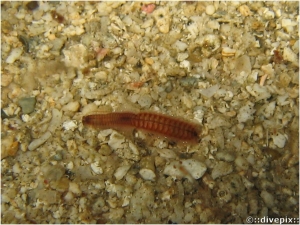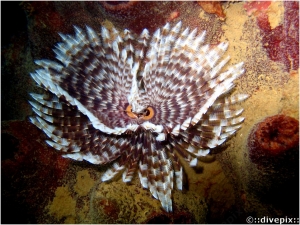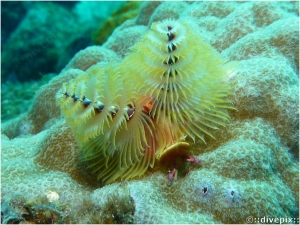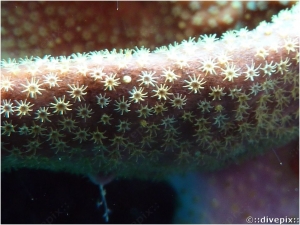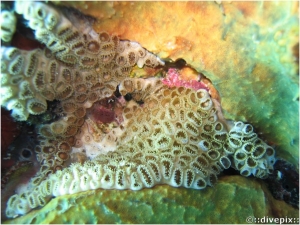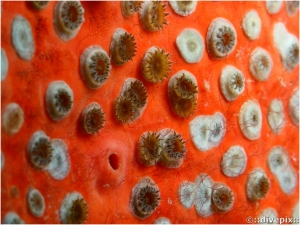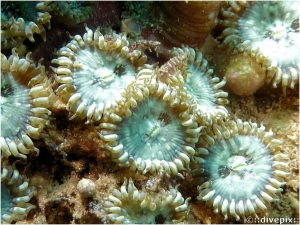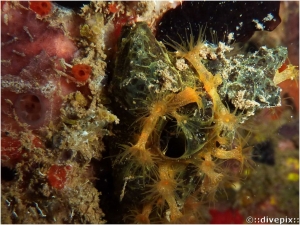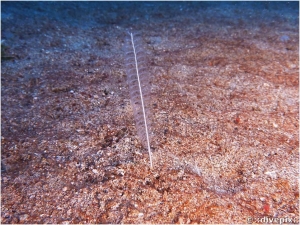




Eric H. Biass
Friday, 29 March 2013 17:16
Magnificent Banded Fanworm
| Aspect: | Appears as an overlap of two radially deployed circular arrays of feathers. As seen in the photographs shown here, colours can vary considerably, although the most common pattern is the banded brown and white seen in the title illustration. |
| Population: | Abundant. |
| Notable feature: | The parchment-like tube can sometimes protrude more generously from the base surface. |
| Environment: | Usually found on coral boulders (like Great Star Coral masses). |
| Behaviour: | Will promptly retract into its tube if approached too closely. |
Published in
Worms
Tagged under
Thursday, 28 March 2013 20:24
Bearded Fireworm
| Aspect: | Although not strictly speaking a "flatworm", this segmented worm is relatively flat, with each segment laterally sprouting tufts of severely irritating white "hairs". Although the head is logically part of the first segment as shown by one of the pictures below, the mouth is located under the second one. The animal is carnivorous, essantially feeding on coral and anemones. |
| Population: | Common. |
| Notable feature: | Usually bright colour combinations of green, red, yellow and turquoise. |
| Environment: | More often seen on sponges, but also on coral boulders and branching corals. |
| Behaviour: | Unconcerned by divers. |
Published in
Worms
Tagged under
Wednesday, 27 March 2013 22:43
Yellow Sponge Zoanthid
Published in
Zoanthids
Tagged under
Wednesday, 27 March 2013 22:27
White Encrusting Zoanthid
| Aspect: |
Whitish mass of encrusting colonies with irregularly shaped oral discs that are more or less tightly squeezed one against the other. Can easily be mistaken for Smooth Flower Coral (q.v) because from a distance, the tentacles curling outwards over the disc edge resemble the coral's septa. |
| Population: | Common. |
| Notable feature: | Oral disc edges feature double rows of tentacles. |
| Environment: | Relatively shallow reefs. |
| Behaviour: | Tentacles retract if touched and mouths shut nearly completely to form domes. |
Published in
Zoanthids
Tagged under
Tuesday, 26 March 2013 18:58
Sponge Zoanthid
| Aspect: | Relatively squat white-ish polyp body crowned by two rows of yellow or brown tentacles numbering a total of 28. Slit mouth is visible in the centre of the oral disc on close-up views. |
| Population: | Regularly abundant. |
| Notable feature: | Hundreds of polyps may densely colonise a variety of sponges and develop a network of stolons that link their gastric cavities (stolons can be seen on one of the close-up views herewith). |
| Environment: | In sponges located in gently swept waters. |
| Behaviour: | - |
Published in
Zoanthids
Tagged under
Tuesday, 26 March 2013 18:15
Golden Zoanthid
| Aspect: | Entirely golden polyp-like anemones that colonise sponges, particularly the green finger or rope types. |
| Population: | Common, very visible during night dives. |
| Notable feature: | Tentacles are arranged in two superimposed rows |
| Environment: | Generally on sponges anchored on solid structures, shipwrecks being a favourite. |
| Behaviour: | - |
Published in
Zoanthids
Tagged under
Monday, 25 March 2013 23:32
Feather Sea Pen
| Aspect: | Actually a variety of anemone, it really looks like a large white feather stuck in the sand. |
| Population: | Common but not over-abundant. |
| Notable feature: | The white to pink-ish stem carries structures that branch out pinnately in a single plane, each with translucent polyps reminiscent of miniature octocoral polyps. |
| Environment: | All the Feather Sea Pens seen here were photographed over a period of several years on the sandy seabed surrounding the Gustavia wreck at 40 metres. |
Published in
Anemones
Tagged under



